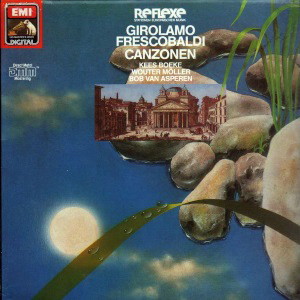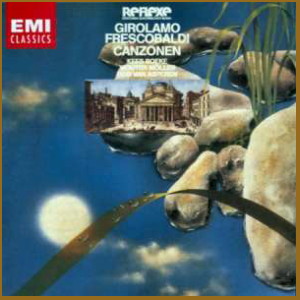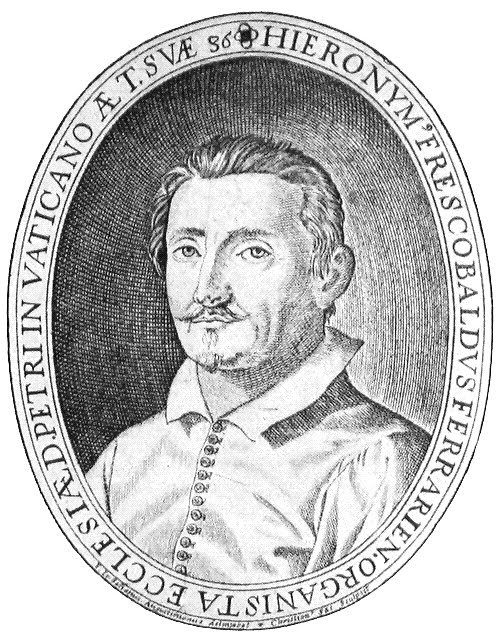 |
1 LP -
1C 069-1466951 - (p) 1983
|

|
| 1 CD - 8
26533 2 - (c) 2000 |
 |
| 1 CD -
CDM 7 63140 2 - (c) 1989 |
|
| GIROLAMO
FRESCOBALDI (1583-1643) - Canzonen |
|
|
|
|
|
| aus "Il primo libro
delle Canzoni a una, due, tre e
quattro voci...", Roma 1628 |
|
|
| - Canzona
decimanona detta La Capriola -
(1a, 2, 3a) |
3' 18" |
|
| - Canzona
seconda - (1b, 3b) |
2' 28" |
|
| - Canzona quinta
detta la Tromboncina - (2,
3a) |
3' 17" |
|
| -
Canzona vigesimaseconda detta la
Nicolina - (1b, 2, 3b) |
4' 43" |
|
| -
Canzona prima detta la Bonvisia
- (1a, 3a) |
3' 12" |
|
| -
Canzona settima detta la Tuccina
o la Superba - (2, 3b) |
3' 28" |
|
| -
Canzona vigesima detta la
Lipparella - (1a, 2, 3a) |
2' 39" |
|
|
|
|
| - Canzona
decimaottava detta la Masotti
- (1b, 2, 3b) |
2' 56" |
|
| - Canzona quarta
detta la Donatina - (1a,
3a) |
2' 33" |
|
| -
Canzona ottava detta lßAmbitiosa
- (2, 3b) |
4' 10" |
|
| - Canzona
vigesimaprima detta la Tegrimuccia
- (1a, 2, 3a) |
2' 30" |
|
| -
Canzona terza detta la Lucchesina
- (1b, 3b) |
2' 53" |
|
| -
Canzona sesta detta l'Altera
- (2, 3a) |
3' 59" |
|
| -
Canzona seconda detta la
Bernardinia - (1a, 3b) |
3' 04" |
|
| -
Canzona vigesimaterza detta la
Fanciotta - (1b, 2, 3a) |
3' 27" |
|
|
|
|
| (alle Werke
lassen sich einordnen nach:
Canto solo, per Basso solo und
per Canto e Basso) |
|
|
|
|
|
| Kees Boeke |
|
| 1a.
Sopranblockflöte (von Frederic
Morgan, Australia, typus:
Ganassi) |
|
| 1b.
Tenorblockflöte (von Friedich
von Hüne) |
|
|
|
| Wouter
Möller |
|
| 2.
Barockvioloncello (von Joannes
Franciscus Celoniatus, Torino
1742) |
|
|
|
| Bob
van Asperen |
|
| 3a.
Cembalo (von Rainer Schütze,
Heidelberg 1969, nach J. D.
Dulcken, Antwerpen 1745) |
|
| 3b.
Orgelpositiv (von Jütgen Ahrend,
Leer/Ostfriesland) |
|
|
|
|
|
Luogo
e data di registrazione |
|
Doopsgezinde
Gemeente Kerk, Haarlem (Olanda) -
4-6 ottobre 1982 |
|
|
Registrazione: live /
studio |
|
studio |
|
|
Producer / Engineer |
|
Gerd
Berg / Hartwig Paulsen |
|
|
Prima Edizione LP |
|
EMI
Electrola "Reflexe" - 1C
069-1466951 - (1 lp) - durata 50'
35" - (p) 1983 - DMM (Digitale) |
|
|
Prima Edizione CD |
|
EMI
"Classics" - CDM 7 63140 2 - (1
cd) - durata 50' 35" - (c) 1989 -
DDD |
|
|
Edizione CD |
|
EMI
"Classics" - 8 26533 2 - (1 cd) -
durata 50' 33" - (c) 2000 - DDD |
|
|
Note |
|
- |
|
|
|
|
|
 GIROLAMO
FRESCOBALDI GIROLAMO
FRESCOBALDI
The
instrumental canzonas of
Girolamo Frescobaldi (Il
primo libro delle canzoni ad
una, due, tre e quattro voci,
accomodate per sonare con
ogni sorte de stromenti)
occupy a rather peculiar
place, both in his own œuvre
and in the history of
instrumental music. At first
glance they seem to be of
comparatively conventional
character, as indeed they are
in the opinion of most
scholars, but there are also
signs of a new approach, a
revolutionizing (to put it
strongly) of the aged canzona
form. Whichever of these two
concepts be the right one,
there is no doubt that
Frescobaldi`s canzonas hardly
had a decisive influence on
the subsequent development of
instrumental composition, most
probably because of their lack
of overt (and novel)
virtuosity, and the
preponderance of contrapuntal
and structural preoccupations.
To assess accurately the
position of Frescobaldi’s opus
in the canzona tradition and
in relation to other
contemporary instrumental
forms, it is necessary to
provide a short chronology of
the developments during the
century preceding its first
publication in 1623 (a date to
which we shall return later).
The types of composition we
should consider in 1523 in
Italy were the ricercare
(usually for four viols and
polyphonic) and the “madrigale
diminuito" or ornamented
madrigal (Ganassi, 1535).
There subsequently emerged the
fantasia (1549, M. Giuliano
Tiburtino), the canzone da
sonare (1572, by N.
Vicentino, who called himself
for the occasion “inventore
delle nuove armonie"), the
concerto (1587 by Andrea and
Giovanni Gabrieli), the
capriccio (1588 by G.
Bassano), the sinfonia (1591,
in the intermedii for
the marriage of Ferdinando de’
Medici) and finally the sonata
(1597, again invented by
Giovanni Gabrieli).
The old ricercare (for more
than one instrument) was
nearly always scored à 4; it
disappeared around 1600. The
ricercares that we still find
after this musical milestone
are practically all two-part
didactic works (for
instrumentalists and singers)
rather than real musical
compositions.
The fantasia played a minor
role in Italy
(in contrast to its English
counterpart) and its form was
never very clearly defined.
Thus we find specimens called
“Fantasie ricercari”,
“Fantasia capriccio”, or
“Fantasia alla francese”
(which is no more than a
disguised canzona). The total
number of publications
containing fantasias amounts
to only twelve between the
form’s first appearance and
its extinction around 1615.
The prodigious canzone/a (alla
francese per sonare)
appears in no fewer than 55
collections between 1572 and
1628; after that there is a
decline towards its final
disappearance around 1650. At
first, as the canzona
displaced the ricercare, it
was usually in four parts, but
after 1600 the number of parts
(besides the newly invented
basso continuo) ranged from 1
to 22. From this moment on we
can observe a decisive
division between the ensemble
canzona of Gabrieli (1597) and
the more soloistic type (à 1, 2
or 3 with continuo)
exemplified for the first time
in G. P. Cima’s publication of
1609. It
is to this latter trend that
Frescobaldi’s compositions
belong. The canzonas in 8, 12
and more parts are in fact no
more than polychoral,
“stereophonic” versions of the
classical four-part model.
Both concerto and sinfonia
were from the first scored for
1 to 8 voices and provided
with basso continuo parts, a
novelty marketed for the first
time (with ample publicity) by
Viadana in his 100
concerti ecclesiatici.
These were published in 1602,
but the new technique had been
developed over the preceding
ten years by several
composers, including Caccini.
Until 1615 the concerto was
always sacred and employed
instruments as well as voices.
It
introduced new vocal
dispositions - two
sopranos and continuo, two
altos, one tenor and continuo,
etc. - and these various
combinations of one, two or
three solo singers and
continuo had a definite
influence on the smaller-scale
canzona. This is reflected in
the frequent inclusion at the
end of concerto collections
of one or two canzoni
alla francese for specific
solo instruments.
The sinfonia remained strictly
instrumental and very
frequently had an introductory
function (for madrigals etc.)
which it was to retain far
into the 17th century and
which ensured its comparative
brevity and superficiality.
Again we see a tendency
towards a more soloistic form,
one developed in the case of
the sinfonia by Salomone Rossi
(1607).
In
general what has been said
above about the fantasia also
applies to the capriccio.
The art of diminution (passegiare)
persisted throughout the
Renaissance and into the
Baroque. In
the period under consideration
here 12 different tutors
appeared in print (in 1535,
1553,
1584,1585,1591,1592,1593,1609,
1614,1620 and 1623), and the
practice was largely
responsible for the
development of the virtuosity
that was to become the main
feature of the sonata.
Launched in 1597, again by
Giovanni Gabrieli, as rather
massive compositions in 8-22
parts, the sonata rapidly
assumed the characteristic
forms that would result in its
enormous popularity: the trio
sonata and the solo sonata,
the first specimens of which
hesitatingly surface in 1610
with the help of Andrea Cima.
It should be stressed, though,
that in the first ten years
after this publication the
distinction between the sonata
and the canzona is not very
clear, and often completely
arbitrary: the six “Canzoni
per sonare” mentioned on the
frontispiece of a 1613 print
of works by Stefano Bernardi
turn out to be sonatas in the
table of contents, while in a
1621 publication of works by
the same composer, where we
are confronted - according to
the title page - for the first
time in history with “alcune
Sonate a tre” for two violins
or cornetti and chitarrone
etc., the table of contents
maintains that in reality we
are dealing with canzonas!
But the year 1621 fortunately
also produces some examples of
the sonata in the form it
would eventually assume,
especially the Sonate a
tre of Francesco Turini
and the Primo libro delle
sonate concertate of
Dario Castello. Here we have
compositions that allow each
solo instrument ample
opportunity to display great
virtuosity and “varii
affetti”. In fact these two
features now became far more
important than constructional
coherence.
Suddenly the instrumental
canzona must have seemed a
rather lowly form of
composition next to the
exuberant sonata, and there is
no reason to assume that
Frescobaldi, who was renowned
as a daring innovator in his
keyboard music, did not
realize this. Seen in this
light, the publication in 1623
(not 1628, incidentally) in
Rome of his Primo libro
delle Canzoni might be
considered a response to the
sonata, in the form of an
attempt to redefine the
instrumental canzona.
As an ardent proponent of the
“stile affettuoso” (many of
the prefaces to his keyboard
works bear this out), he
apparently preferred the
combining of compositional and
constructional virtuosity with
affetto to a more
superficial, instrumentalist’s
virtuosity (which, as an
eminent player himself, he
probably took for granted).
This would also explain why in
the remaining 20 years of his
life he continued to eschew
the sonata: his goals as a
composer (of revolutionary
elan) were out of step with
developments around him,
rooted as he was so deeply in
the tradition that stemmed in
a direct line from Luzzaschi,
de Rore and Willaert.
Frescobaldi’s canzonas were
published four times during
his lifetime:
- In a set of parts in Rome by
Robletti in 1623, with a
reprint in 1628.
- In
score by his pupil Bartolomeo
Grassi (Rome, 1628); this is
more or less identical with
the Robletti prints, except
for the titles given to the
canzonas.
- In a set of parts,
substantially different from
earlier versions, published in
Venice in 1634 by Vincenti.
One gets the feeling that the
1634 revision perhaps reflects
the pressure of developments
in instrumental music since
1623: in its sometimes
radically simplified basso
continuo lines (which create a
more monodic effect, as of a
soloist with basso continuo)
and in its generally looser,
more improvisatory structure
(achieved by leaving out
several passages in the 1623
edition and reordering other
material).
For this recording we have,
obviously, preferred to follow
the earlier 1623 and 1628
prints, since they reflect
Frescobaldi's
original intentions.
Kees
Boeke, 1983
|
|
|
EMI Electrola
"Reflexe"
|
|
|
|

